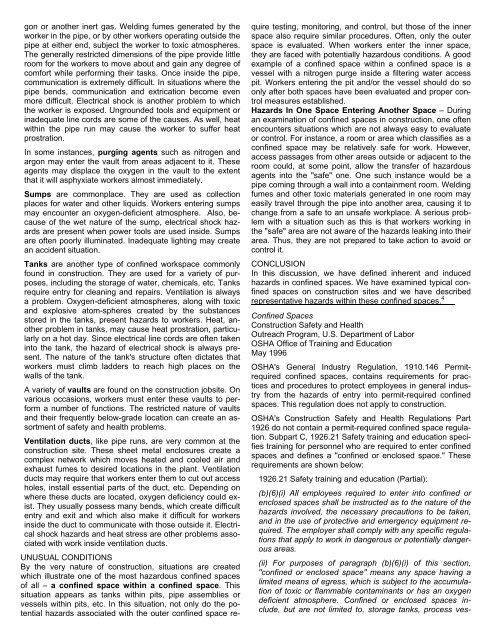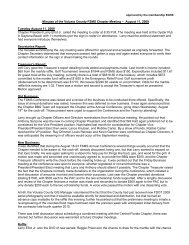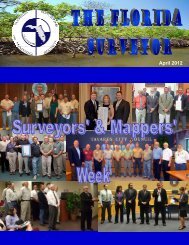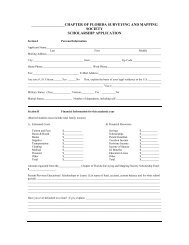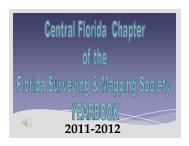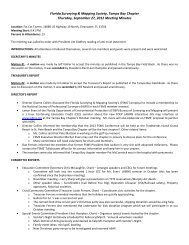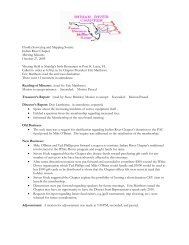July 2012 - FSMS
July 2012 - FSMS
July 2012 - FSMS
Create successful ePaper yourself
Turn your PDF publications into a flip-book with our unique Google optimized e-Paper software.
gon or another inert gas. Welding fumes generated by the<br />
worker in the pipe, or by other workers operating outside the<br />
pipe at either end, subject the worker to toxic atmospheres.<br />
The generally restricted dimensions of the pipe provide little<br />
room for the workers to move about and gain any degree of<br />
comfort while performing their tasks. Once inside the pipe,<br />
communication is extremely difficult. In situations where the<br />
pipe bends, communication and extrication become even<br />
more difficult. Electrical shock is another problem to which<br />
the worker is exposed. Ungrounded tools and equipment or<br />
inadequate line cords are some of the causes. As well, heat<br />
within the pipe run may cause the worker to suffer heat<br />
prostration.<br />
In some instances, purging agents such as nitrogen and<br />
argon may enter the vault from areas adjacent to it. These<br />
agents may displace the oxygen in the vault to the extent<br />
that it will asphyxiate workers almost immediately.<br />
Sumps are commonplace. They are used as collection<br />
places for water and other liquids. Workers entering sumps<br />
may encounter an oxygen-deficient atmosphere. Also, because<br />
of the wet nature of the sump, electrical shock hazards<br />
are present when power tools are used inside. Sumps<br />
are often poorly illuminated. Inadequate lighting may create<br />
an accident situation.<br />
Tanks are another type of confined workspace commonly<br />
found in construction. They are used for a variety of purposes,<br />
including the storage of water, chemicals, etc. Tanks<br />
require entry for cleaning and repairs. Ventilation is always<br />
a problem. Oxygen-deficient atmospheres, along with toxic<br />
and explosive atom-spheres created by the substances<br />
stored in the tanks, present hazards to workers. Heat, another<br />
problem in tanks, may cause heat prostration, particularly<br />
on a hot day. Since electrical line cords are often taken<br />
into the tank, the hazard of electrical shock is always present.<br />
The nature of the tank's structure often dictates that<br />
workers must climb ladders to reach high places on the<br />
walls of the tank.<br />
A variety of vaults are found on the construction jobsite. On<br />
various occasions, workers must enter these vaults to perform<br />
a number of functions. The restricted nature of vaults<br />
and their frequently below-grade location can create an assortment<br />
of safety and health problems.<br />
Ventilation ducts, like pipe runs, are very common at the<br />
construction site. These sheet metal enclosures create a<br />
complex network which moves heated and cooled air and<br />
exhaust fumes to desired locations in the plant. Ventilation<br />
ducts may require that workers enter them to cut out access<br />
holes, install essential parts of the duct, etc. Depending on<br />
where these ducts are located, oxygen deficiency could exist.<br />
They usually possess many bends, which create difficult<br />
entry and exit and which also make it difficult for workers<br />
inside the duct to communicate with those outside it. Electrical<br />
shock hazards and heat stress are other problems associated<br />
with work inside ventilation ducts.<br />
UNUSUAL CONDITIONS<br />
By the very nature of construction, situations are created<br />
which illustrate one of the most hazardous confined spaces<br />
of all – a confined space within a confined space. This<br />
situation appears as tanks within pits, pipe assemblies or<br />
vessels within pits, etc. In this situation, not only do the potential<br />
hazards associated with the outer confined space require<br />
testing, monitoring, and control, but those of the inner<br />
space also require similar procedures. Often, only the outer<br />
space is evaluated. When workers enter the inner space,<br />
they are faced with potentially hazardous conditions. A good<br />
example of a confined space within a confined space is a<br />
vessel with a nitrogen purge inside a filtering water access<br />
pit. Workers entering the pit and/or the vessel should do so<br />
only after both spaces have been evaluated and proper control<br />
measures established.<br />
Hazards In One Space Entering Another Space – During<br />
an examination of confined spaces in construction, one often<br />
encounters situations which are not always easy to evaluate<br />
or control. For instance, a room or area which classifies as a<br />
confined space may be relatively safe for work. However,<br />
access passages from other areas outside or adjacent to the<br />
room could, at some point, allow the transfer of hazardous<br />
agents into the "safe" one. One such instance would be a<br />
pipe coming through a wall into a containment room. Welding<br />
fumes and other toxic materials generated in one room may<br />
easily travel through the pipe into another area, causing it to<br />
change from a safe to an unsafe workplace. A serious problem<br />
with a situation such as this is that workers working in<br />
the "safe" area are not aware of the hazards leaking into their<br />
area. Thus, they are not prepared to take action to avoid or<br />
control it.<br />
CONCLUSION<br />
In this discussion, we have defined inherent and induced<br />
hazards in confined spaces. We have examined typical confined<br />
spaces on construction sites and we have described<br />
representative hazards within these confined spaces. 4<br />
Confined Spaces<br />
Construction Safety and Health<br />
Outreach Program, U.S. Department of Labor<br />
OSHA Office of Training and Education<br />
May 1996<br />
OSHA's General Industry Regulation, 1910.146 Permitrequired<br />
confined spaces, contains requirements for practices<br />
and procedures to protect employees in general industry<br />
from the hazards of entry into permit-required confined<br />
spaces. This regulation does not apply to construction.<br />
OSHA's Construction Safety and Health Regulations Part<br />
1926 do not contain a permit-required confined space regulation.<br />
Subpart C, 1926.21 Safety training and education specifies<br />
training for personnel who are required to enter confined<br />
spaces and defines a "confined or enclosed space." These<br />
requirements are shown below:<br />
1926.21 Safety training and education (Partial):<br />
(b)(6)(i) All employees required to enter into confined or<br />
enclosed spaces shall be instructed as to the nature of the<br />
hazards involved, the necessary precautions to be taken,<br />
and in the use of protective and emergency equipment required.<br />
The employer shall comply with any specific regulations<br />
that apply to work in dangerous or potentially dangerous<br />
areas.<br />
(ii) For purposes of paragraph (b)(6)(i) of this section,<br />
"confined or enclosed space" means any space having a<br />
limited means of egress, which is subject to the accumulation<br />
of toxic or flammable contaminants or has an oxygen<br />
deficient atmosphere. Confined or enclosed spaces include,<br />
but are not limited to, storage tanks, process ves-


